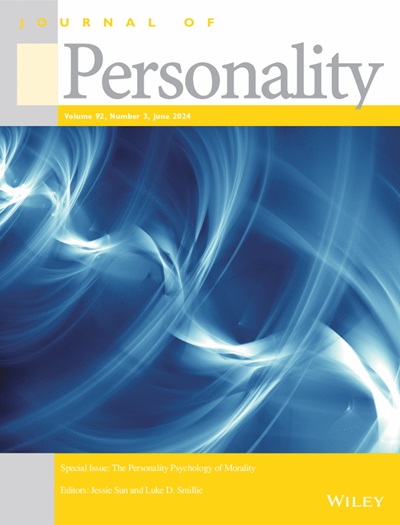贯穿一生的谦逊和全球流行病:来自大规模横断面研究的证据
IF 2.7
1区 心理学
Q1 Psychology
引用次数: 0
摘要
目的:我们提供了谦逊在整个生命周期中年龄分级差异的细粒度肖像。具体而言,我们揭示了年复一年的差异,并探讨了COVID大流行后的差异。方法:我们使用大规模横断面数据(n = 2,025,004),并采用多组验证性因素分析、方差分析和多水平模型来检验整个样本中10至70岁人群谦逊的平均得分差异,以及时间(前冠状病毒、新冠病毒)和地理(9个国家、6个美国州)子样本的差异。结果在不同的文化和地域中,谦逊意味着在童年后期得分最低,此后稳步上升。它们在成年后期达到最高水平,在退休年龄前后表现出更不稳定的模式。在总体和前COVID样本中,平均得分差异在从成年早期到中年的过渡期间最为明显。在COVID样本中,出现了类似的模式,尽管我们观察到普遍较高的谦逊得分,明显的青春期中断,以及成年早期和中年之间的最大差异。结论:谦逊的sage分级趋势与人格特质发展的一些既定模式(即心理成熟、成熟逆转)完全一致,部分与其他模式(即中断假设)一致。此外,COVID分析提供了关于大流行对人格发展轨迹的潜在影响的初步见解。本文章由计算机程序翻译,如有差异,请以英文原文为准。
Humility Throughout the Lifespan and a Global Pandemic: Evidence From a Large‐Scale Cross‐Sectional Study
ObjectiveWe provide a fine‐grained portrait of age‐graded differences in Humility across the lifespan. Specifically, we shed light on year‐by‐year differences and explore differences‐in‐differences in the wake of the COVID pandemic.MethodsWe used large‐scale cross‐sectional data (n = 2,025,004) and employed multigroup confirmatory factor analysis, ANOVAs, and multilevel modeling to examine mean‐score differences in Humility from age 10 to 70 across the entire sample, and for temporal (pre‐COVID, COVID) and geographical (9 countries, 6 US states) subsamples.ResultsAcross cultures and geographies, Humility mean scores were lowest in late childhood and rose steadily thereafter. They reached their highest levels in late adulthood and exhibited more erratic patterns around retirement age. In the overall and pre‐COVID samples, mean‐score differences were most pronounced during the transition from early to middle adulthood. In the COVID sample, similar patterns emerged, though we observed generally higher Humility scores, pronounced adolescent disruption, and the biggest differences between early and middle adulthood.ConclusionsAge‐graded trends in Humility aligned fully with some established patterns of personality trait development (i.e., psychological maturation, maturation reversal) and partially with others (i.e., disruption hypothesis). Moreover, the COVID analyses provide preliminary insights into the potential effects of the pandemic on personality development trajectories.
求助全文
通过发布文献求助,成功后即可免费获取论文全文。
去求助
来源期刊

Journal of Personality
PSYCHOLOGY, SOCIAL-
CiteScore
9.60
自引率
6.00%
发文量
100
期刊介绍:
Journal of Personality publishes scientific investigations in the field of personality. It focuses particularly on personality and behavior dynamics, personality development, and individual differences in the cognitive, affective, and interpersonal domains. The journal reflects and stimulates interest in the growth of new theoretical and methodological approaches in personality psychology.
 求助内容:
求助内容: 应助结果提醒方式:
应助结果提醒方式:


